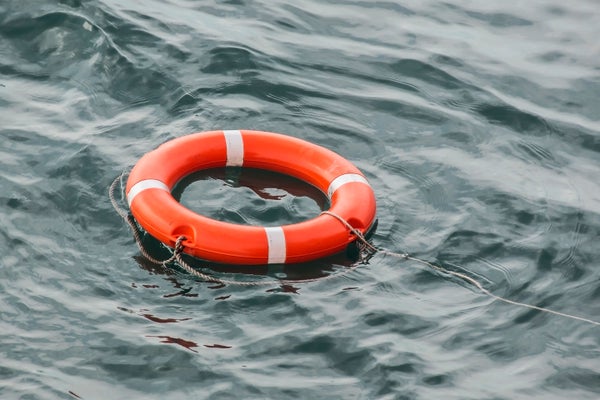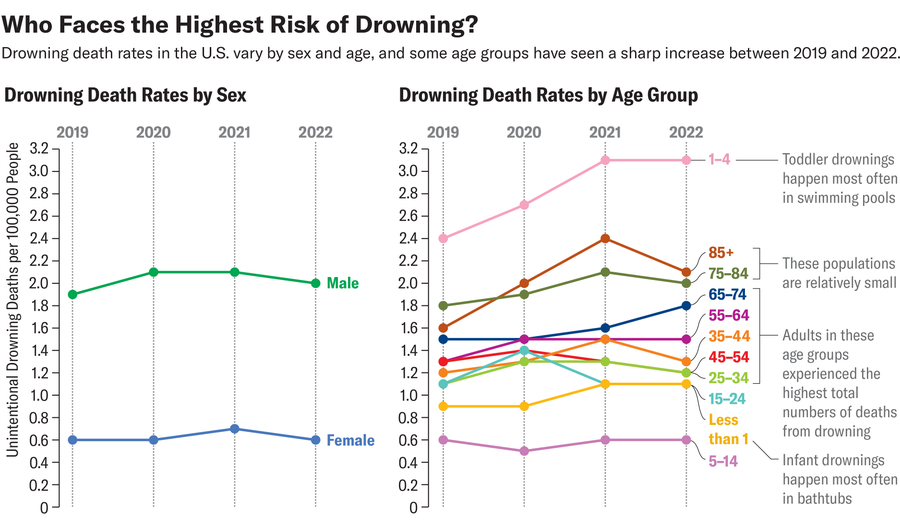August 27, 2024
4 Time required to read
Increase in adult drowning deaths
The majority of drownings in the United States involve adults, not children, and alcohol is often involved.

In 2022, the most recent year for which data is available, more than 4,500 people lost their lives to drownings in the United States, more than 70% of whom were adults. This summer was marked by several notable adult drownings, including the deaths of three young people on a Florida beach in June and the death of award-winning chef Naomi Pomeroy in a river tubing accident in Oregon in July.
Drowning deaths among adults are on the rise in the U.S. A recent Centers for Disease Control report found that accidental drowning rates increased across nearly every adult age group between 2020 and 2022, when the COVID-19 pandemic led to pool closures and lifeguard shortages.
“This increase is concerning because drowning deaths have been trending downward in the United States for the past 20 years,” said CDC researcher Brianna Moreland, co-author of the report. The reasons for the trend aren’t entirely clear, but as the agency’s previous report noted, people have spent more time outdoors during the pandemic, leading to increased boat sales. Learning more about the factors that lead to drownings among adults may allow researchers to develop better prevention strategies.
Supporting science journalism
If you enjoyed this article, please support our award-winning journalism. Subscribe. By purchasing a subscription, you help ensure a future of influential stories about the discoveries and ideas shaping the world today.

Despite its high incidence, drowning in adults tends to receive far less attention than drowning in children, in part because toddlers make up the highest drowning death rate in the United States. Drowning prevention campaigns typically focus on promoting swimming lessons for children and feature photos of young children in pools. “Drowning prevention has been so focused on children that it’s odd to hear a pediatrician say something like this,” says Linda Quan, a pediatric drowning expert at the University of Washington. “Losing a child is awful, but losing a parent is also devastating for a child. It affects the whole family.”
One factor that distinguishes drownings between adults and children is the water source. While young children are more likely to drown in bathtubs or pools, most adult drownings occur in natural bodies of water like rivers or oceans. These bodies of water may appear calm but can harbor hidden dangers, like currents or steep cliffs. “Every natural waterway is different,” says Adam B. Caccimarchi, CEO of the National League for Drowning Prevention, a nonprofit that researches and promotes water safety. “We sometimes underestimate the power of water, and as adults, we tend to think that nothing bad can happen.”
Drownings among adults often involve alcohol, which can impair judgment and coordination. “If you fall into the water while intoxicated, your ability to coordinate breathing and muscle movements is certainly not as clear as it would be if you were sober,” says Steven Hargarten, a professor of emergency medicine at the Medical College of Wisconsin who has written about drowning. In the United States, it is already illegal to operate a boat while intoxicated, and drinking is prohibited at many public beaches. Still, alcohol remains the leading contributing factor in fatal boating accidents in the United States, with 564 people dying in boating accidents last year, most of them drownings, according to the U.S. Coast Guard.
Another factor that influences how adults behave around water is their perception of their swimming ability. For example, research by Quan and others has found that many boaters believe that only inexperienced swimmers should wear life jackets. Men are especially likely to rate themselves as good swimmers, yet a recent CDC report found that fewer than half of adult men in the U.S. have ever taken swimming lessons.
Understanding male drowning is important because men are the most at risk of all age groups, accounting for approximately 75 percent of unintentional drownings in the United States. Evidence suggests that men and boys are generally more likely to engage in risk-taking behaviors, which increases their chances of dying from injuries other than drowning, such as motor vehicle accidents. However, misperceiving their swimming ability may also lead to inaccurate judgments of risk levels around water. A New Zealand-based study published earlier this year found that male adults consistently overestimate how far they can swim, especially in natural water sources. Perhaps most concerning, many male study participants continued to overestimate their swimming ability even after field tests revealed deficiencies in their swimming ability.
Swimming skills alone don’t prevent drownings. Experts from the American Red Cross and other organizations say more protections, like lifeguards and life jackets, are needed. Still, swimming lessons provide an opportunity to teach children and adults about water safety issues, including natural water hazards and traditional swimming techniques. The U.S. National Water Safety Action Plan, released last year by an interdisciplinary coalition of experts, recommends improving access to swimming and water safety training for all age groups, but especially for Native Americans, Alaska Natives and Blacks, groups that experience disproportionately high rates of drowning among teens and adults. “Our message is that swimming is for everyone,” says Caccimarchi, who helped draft the plan. “These skills are relevant to everyone’s safety.”

